Table of Contents
- Introduction
- Editor’s Choice
- Global Collaboration Software Market Statistics
- Usage of Digital Workplace Technologies Among Workers Worldwide – By Category
- Popular Business Intelligence Software
- Major Office Productivity Software
- Top Video Conferencing Software
- Adoption of Collaboration Software Solutions Statistics
- Benefits of Collaboration Software Solutions Statistics
- Challenges in the Adoption of Collaboration Software Solutions
- Recent Developments
- Conclusion
- FAQs
Introduction
Collaboration Software Statistics: Collaboration software is vital for enhancing communication, teamwork, and project management in organizations. It features real-time messaging, video calls, task management, and document-sharing capabilities.
The main advantages include boosting productivity by minimizing emails and meetings, fostering clearer communication, and accommodating remote work.
However, it faces challenges like adoption resistance, information overload, and security concerns. Looking ahead, trends like artificial intelligence for task automation, virtual reality for more engaging interactions, and blockchain for security promise to innovate and improve collaboration tools, making teamwork more efficient in the evolving digital environment.
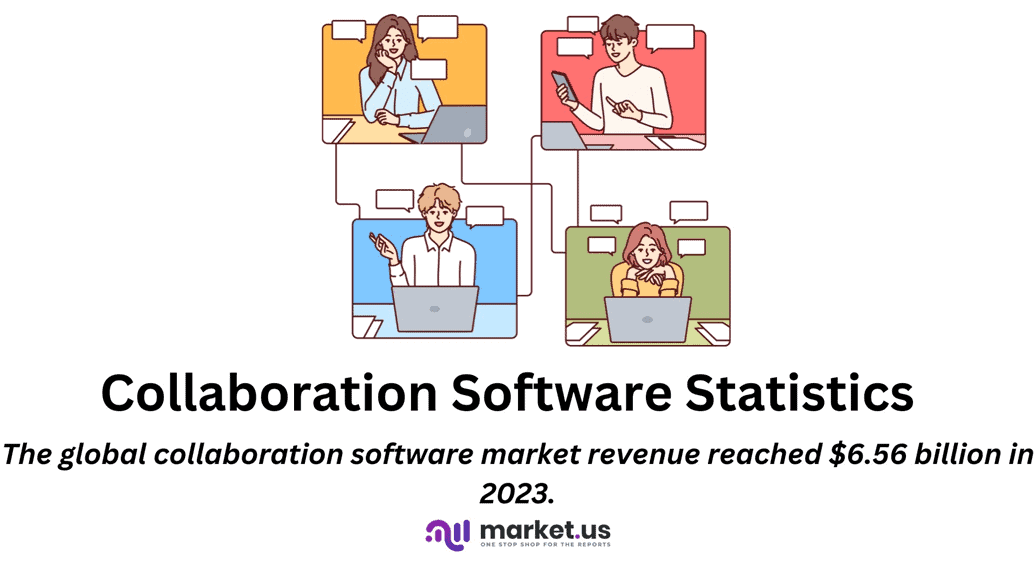
Editor’s Choice
- The global collaboration software market revenue reached $6.56 billion in 2023.
- The trend of deceleration of the collaboration software market continued in 2023 and 2024, with growth rates tapering to 3.87% and 3.11%, respectively.
- In the competitive landscape of the collaboration software market, Microsoft leads with a commanding 38% market share, reflecting its dominant position.
- The United States leads by a wide margin, generating $7,611 million, which underscores its dominant position in this sector.
- Collaboration tools experienced a notable increase in adoption, with the share of respondents using them rising from 55% in 2019 to 79% in 2021, underscoring the growing importance of teamwork and communication in remote settings.
- Microsoft’s Office Productivity and Business Process segment leads the office productivity software landscape with a substantial revenue of $14.7 billion.
- In 2021, a significant 79% of workers globally utilized digital collaboration tools.
Global Collaboration Software Market Statistics
Collaboration Software Market Size Statistics
- The global collaboration software market has been on a trajectory of steady growth at a CAGR of 13.1%, as evidenced by its revenue figures.
- In 2022, the market was valued at $5.80 billion. By 2023, it experienced growth, reaching $6.56 billion, and continued to rise to $7.42 billion in 2024.
- The upward trend persisted through the years, with market revenues hitting $8.39 billion in 2025, $9.49 billion in 2026, and further climbing to $10.73 billion in 2027.
- The growth momentum didn’t stop there; in 2028, the market value rose to $12.14 billion, followed by a significant increase to $13.73 billion in 2029.
- Entering the next decade, the market continued to expand, with revenues reaching $15.53 billion in 2030, escalating to $17.56 billion by 2031, and finally, achieving a notable $19.86 billion in 2032.
- This consistent growth underscores the increasing reliance on and the importance of collaboration software in facilitating effective communication and project management across organizations globally.
(Source: Market.us)
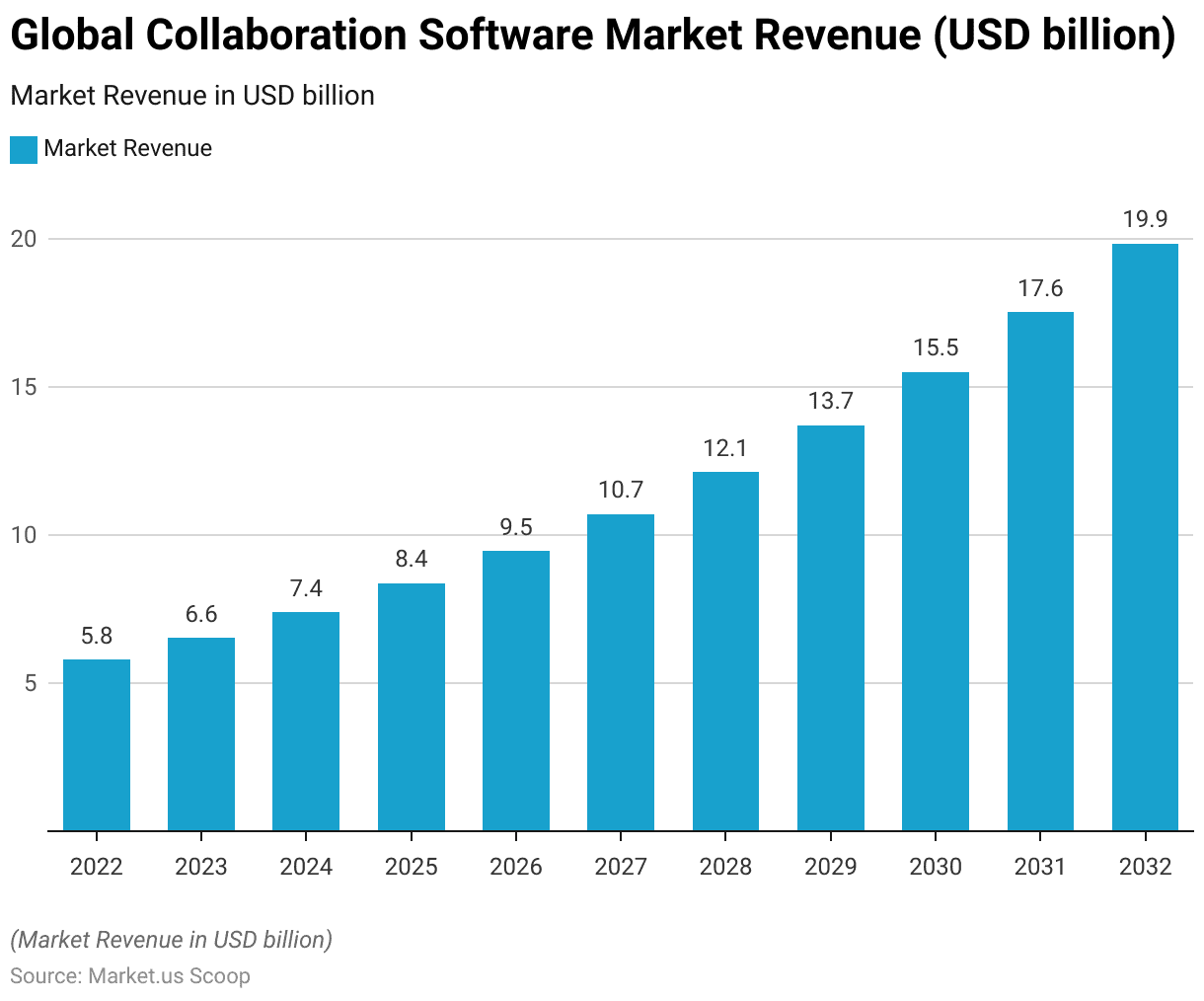
Change in the Collaboration Software Market Revenue Statistics
- Over the years, the collaboration software market has seen fluctuating growth rates in its revenue.
- Starting in 2018, the market expanded by 8.56%, reflecting a robust increase.
- This growth slightly decelerated in 2019, with a 5.87% rise, before surging to an 11.39% increase in 2020, likely driven by the global shift towards remote work amid the pandemic.
- In 2021, the growth moderated to 9.23%, followed by a further slowdown to 4.95% in 2022. The trend of deceleration continued into 2023 and 2024, with growth rates tapering to 3.87% and 3.11%, respectively.
- By 2025, the rate of increase had decreased to 2.1%, closely followed by a similar 2.09% in 2026.
- The growth rate diminished further to 1.74% in 2027, indicating a market approaching saturation.
- In 2028, the growth slowed significantly to just 0.97%, suggesting a mature market with limited expansion opportunities.
- This trajectory highlights the dynamic nature of the collaboration software market, initially benefiting from rapid adoption and later stabilizing as it becomes an integral part of business operations worldwide.
(Source: Statista)
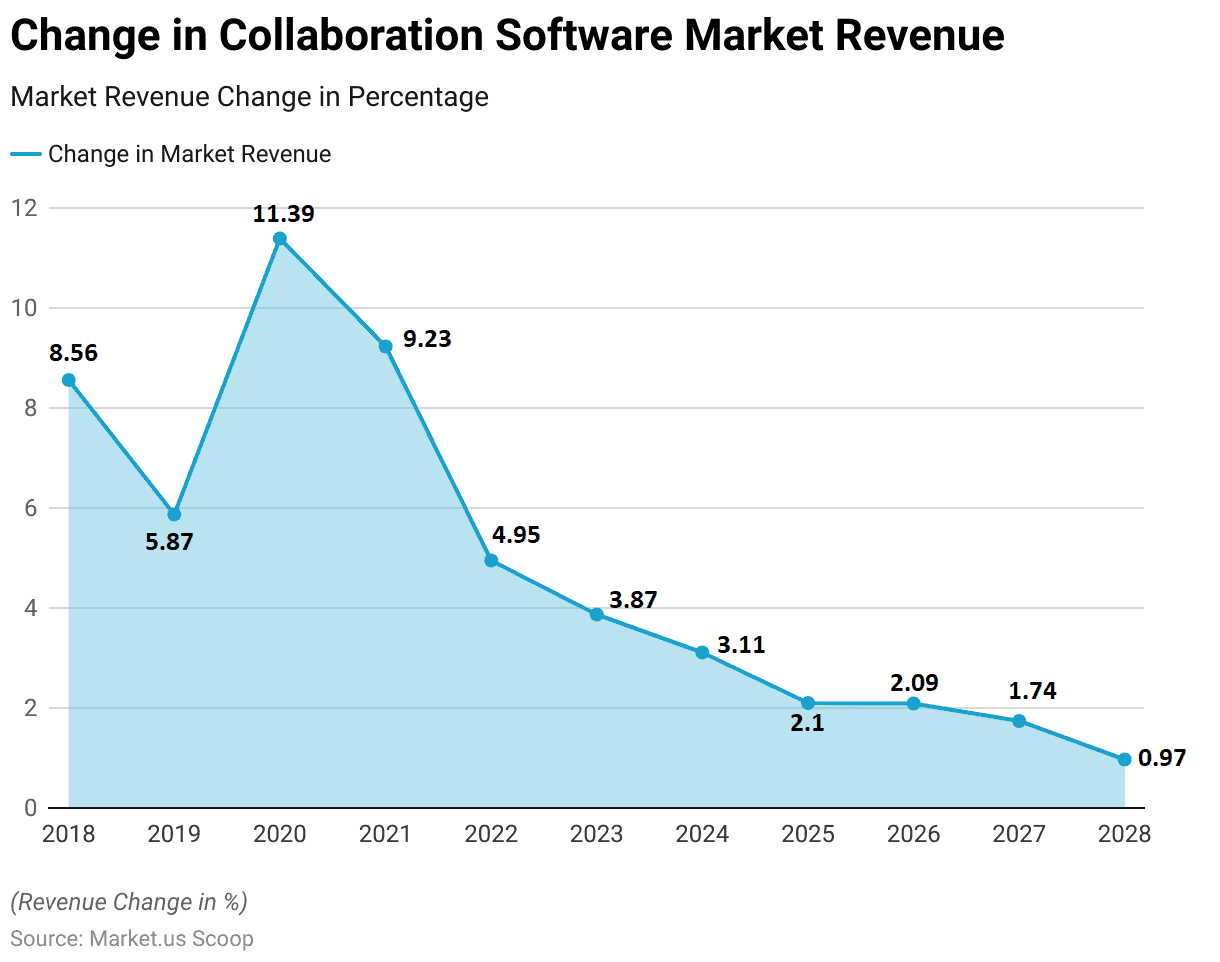
Key Brands in the Collaboration Software Market Statistics
- In the competitive landscape of the collaboration software market, Microsoft leads with a commanding 38% market share, reflecting its dominant position.
- Google follows with a significant 21% share, showcasing its substantial presence.
- Zoom captures 15% of the market, emphasizing its strong foothold in video conferencing.
- RingCentral holds a smaller portion, with 6%, while Slack trails closely with 5%, indicating its niche but impactful role.
- GoTo contributes 4% to the market share, highlighting its steady presence.
- TeamViewer and Webex each hold a modest 2%, demonstrating their specialized roles within the sector.
- The remaining 7% of the market is occupied by other players, pointing to a diverse and fragmented market landscape beyond the leading brands.
- This distribution underscores the varied preferences and needs of organizations for collaboration tools, with a mix of large and smaller players, each finding their place in the ecosystem.
(Source: Statista)
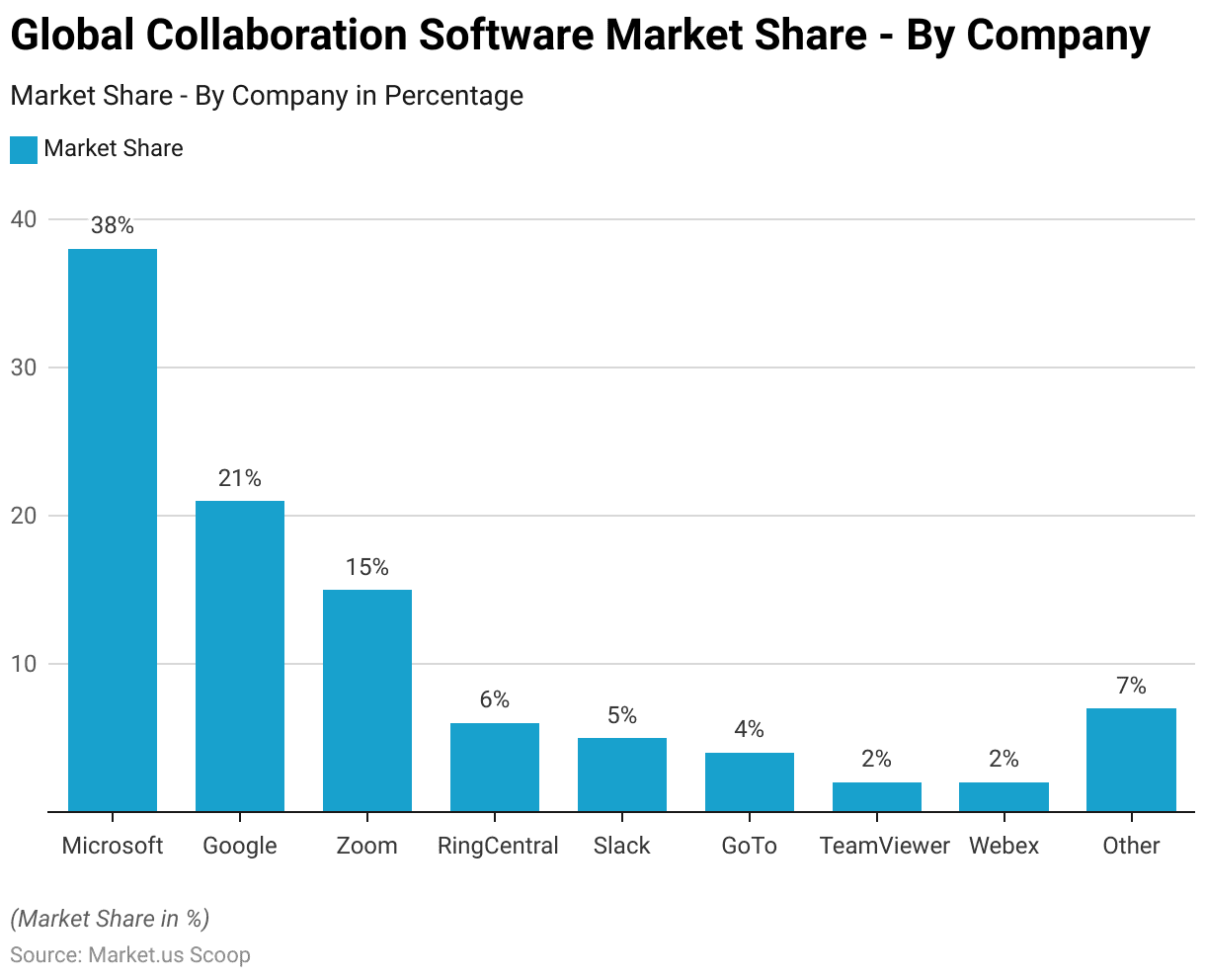
Regional Analysis of the Collaboration Software Market Statistics
- The collaboration software market exhibits significant revenue disparities across different countries.
- The United States leads by a wide margin, generating $7,611 million, which underscores its dominant position in this sector.
- China follows with a revenue of $867.2 million, reflecting its growing market. The United Kingdom also shows strong performance, with revenues reaching $789.8 million.
- Germany and Japan contribute $646.3 million and $535.6 million, respectively, highlighting their robust markets.
- Canada’s market generates $477.9 million, while France’s stands at $361.4 million, showing notable contributions to the global landscape.
- Australia and Brazil, with revenues of $254.5 million and $211.6 million, respectively, indicate the market’s expansion into diverse regions.
- India, closely trailing with a revenue of $209.9 million, reflects its emerging role in the global collaboration software space.
- These figures illustrate the varied impact and adoption of collaboration software across major economies, indicating both developed and developing countries’ reliance on these technologies for enhancing business operations and productivity.
(Source: Statista)
Take advantage of our unbeatable offer - buy now!

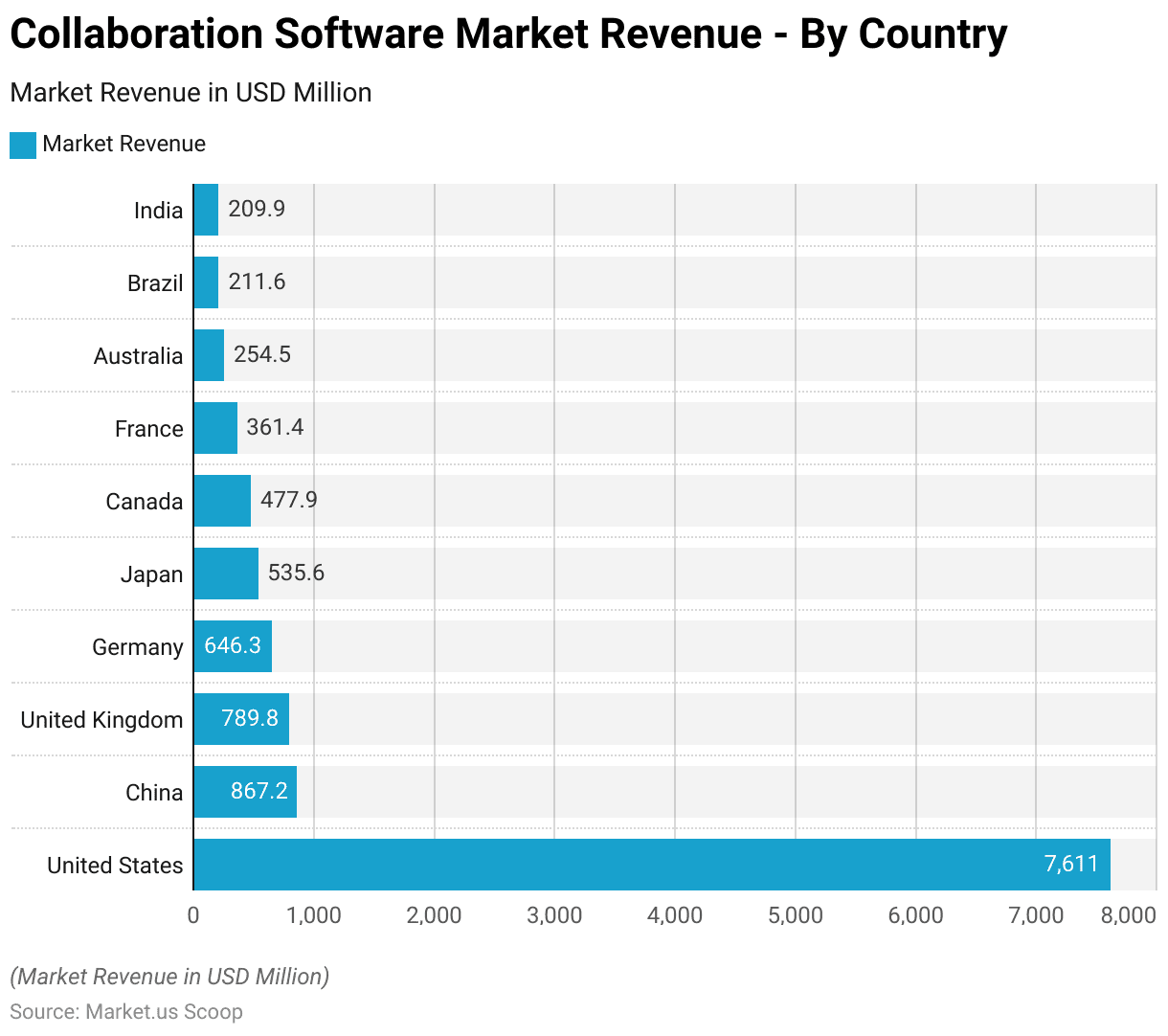
Usage of Digital Workplace Technologies Among Workers Worldwide – By Category
- Between 2019 and 2021, the usage of digital workplace technologies among workers worldwide saw significant changes across various categories, reflecting the evolving dynamics of the modern workplace.
- Collaboration tools experienced a notable increase in adoption, with the share of respondents using them rising from 55% in 2019 to 79% in 2021, underscoring the growing importance of teamwork and communication in remote settings.
- Storage and sharing tools also saw an uptick, moving from 64% to 74%, highlighting the increased need for accessible and efficient data management.
- In contrast, the utilization of training or personal development tools remained steady at 47%, indicating a stable demand for self-improvement and skill-enhancement resources.
- Real-time mobile messaging tools, essential for instant communication, slightly grew in popularity, with their usage moving from 75% to 80%.
- These shifts illustrate the critical role digital workplace technologies play in facilitating efficient work processes, collaboration, and continuous learning in an increasingly digital work environment.
(Source: Statista)
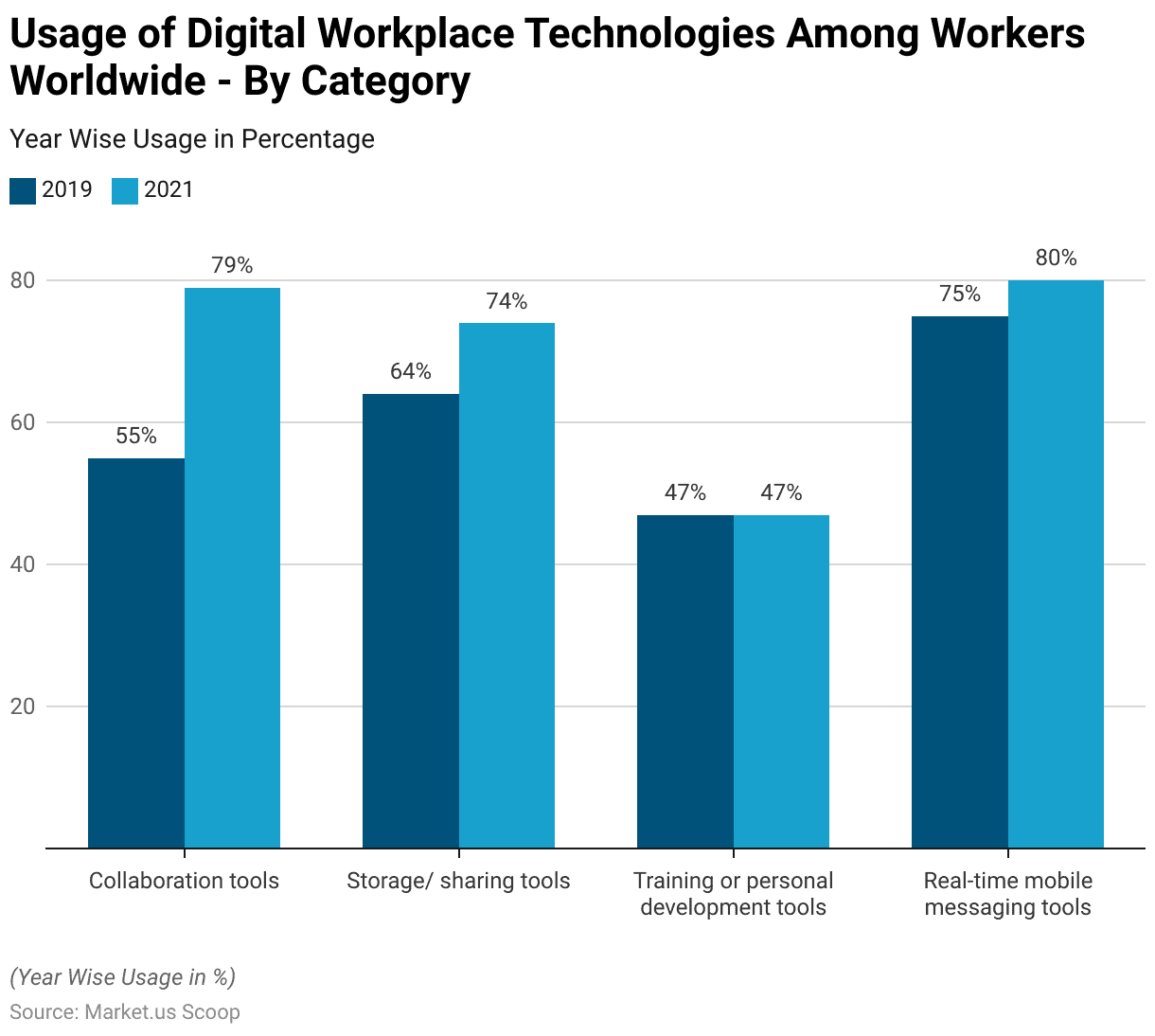
Popular Business Intelligence Software
- In the global Business Intelligence (BI) software market, the distribution of market share among the top BI software vendors showcases a diverse competitive landscape.
- Mode leads the pack with a significant 17.22% share, indicating its prominent position in the industry.
- Following Mode, Tableau holds an 11.24% market share, reflecting its strong presence and the widespread adoption of its visualization tools.
- Microsoft SQL Server Reporting Services captures 9.39% of the market, demonstrating Microsoft’s influence in the BI space.
- SAP Crystal Reports, another key player, accounts for 8.60% of the market, showcasing its role in reporting and analytics.
- IBM Cognos Enterprise holds a smaller portion of the market at 4.40%, indicating its niche but stable position.
- The remaining 49.15% of the market is occupied by ‘Other’ vendors, highlighting the fragmentation of the BI software market and the existence of numerous smaller players that cater to specific needs and segments.
- This distribution underscores the competitive nature of the BI software industry, with a mix of established companies and emerging players contributing to its dynamics.
(Source: Datanyze, 2021)
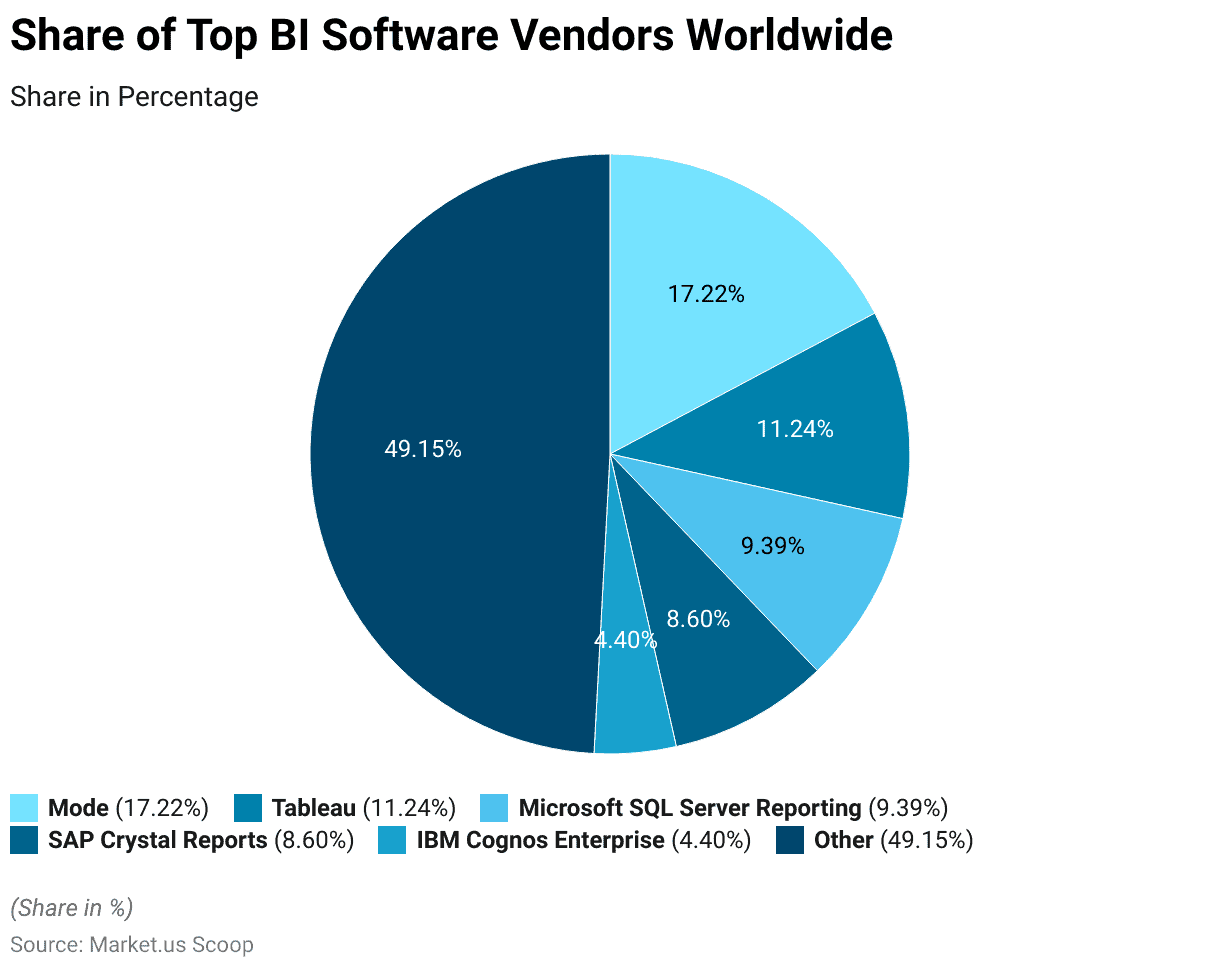
Major Office Productivity Software
- The landscape of major office productivity software is defined by significant revenue streams that reflect the market share and dominance of leading tech companies.
- Microsoft’s Office Productivity and Business Process segment leads with a substantial revenue of $14.7 billion. It underscores its pivotal role in the office productivity software market with widely used applications such as Word, Excel, and PowerPoint.
- Google Cloud follows with a revenue of $4.6 billion, indicating its strong presence in the market with cloud-based productivity tools that foster collaboration and efficiency.
- Cisco’s Applications Segment, contributing $1.34 billion in revenue, also plays a crucial role by offering a suite of collaboration tools that enhance communication and productivity in businesses.
- These figures highlight the competitive dynamics within the office productivity software market, showcasing how these companies cater to the evolving needs of the digital workplace.
(Source: Microsoft, Google, Cisco)
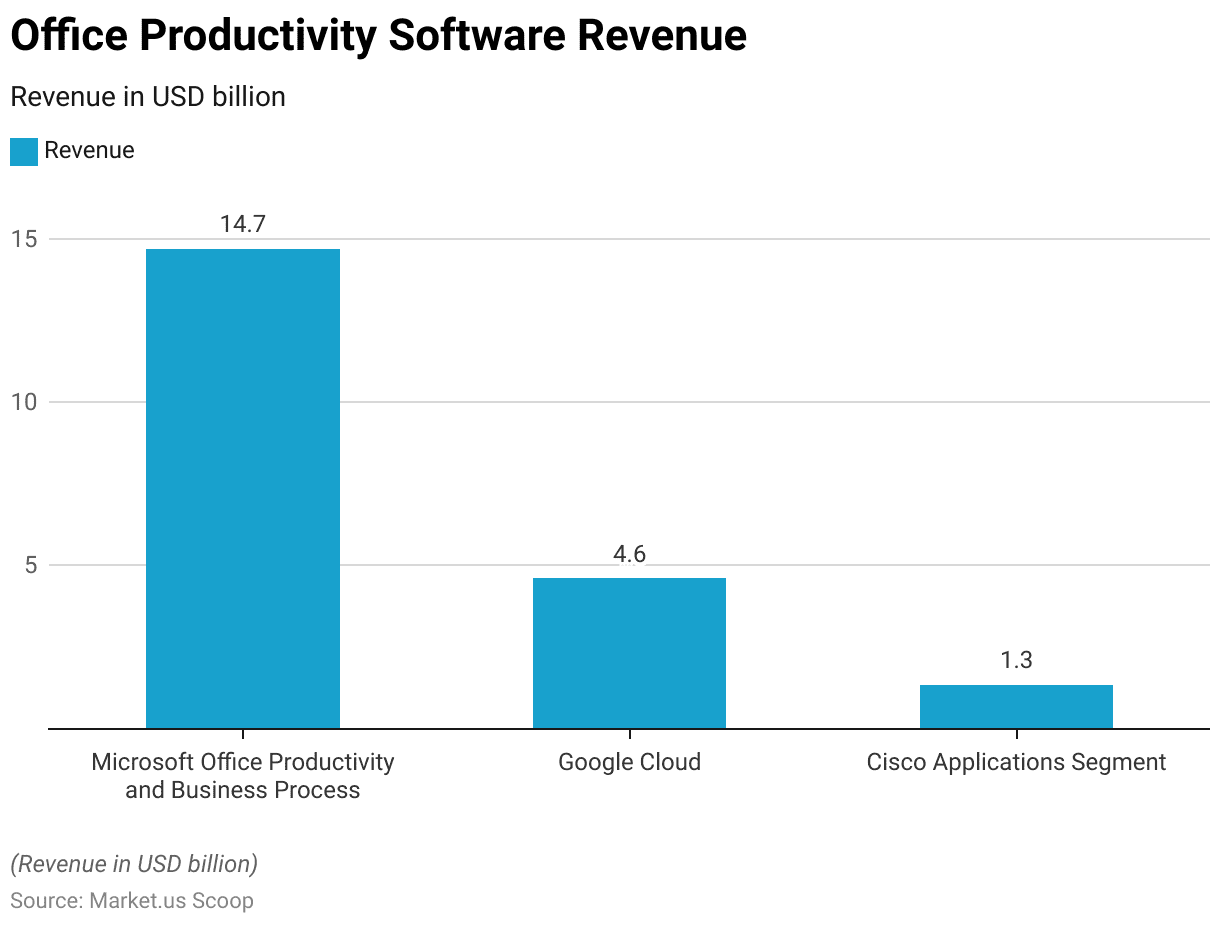
Top Video Conferencing Software
- In 2021, the video conferencing software market was predominantly led by Zoom, capturing a significant 50% market share, highlighting its dominance and widespread adoption for virtual meetings.
- Microsoft Teams followed as a strong contender, securing 23% of the market, reflecting its integration within the corporate and educational sectors.
- Webex Meetings held an 11% share, indicating its steady presence in the professional video conferencing space.
- Team Viewer, known for its remote control and support features alongside video conferencing, accounted for 8% of the market.
- Google Meet, part of the Google Workspace suite, maintained a 4% share, showcasing its role in facilitating online meetings and collaborations.
- This distribution underscores the competitive landscape of the video conferencing software market, with Zoom leading the pack amidst a diverse range of platforms catering to various user needs.
(Source: TrustRadius)
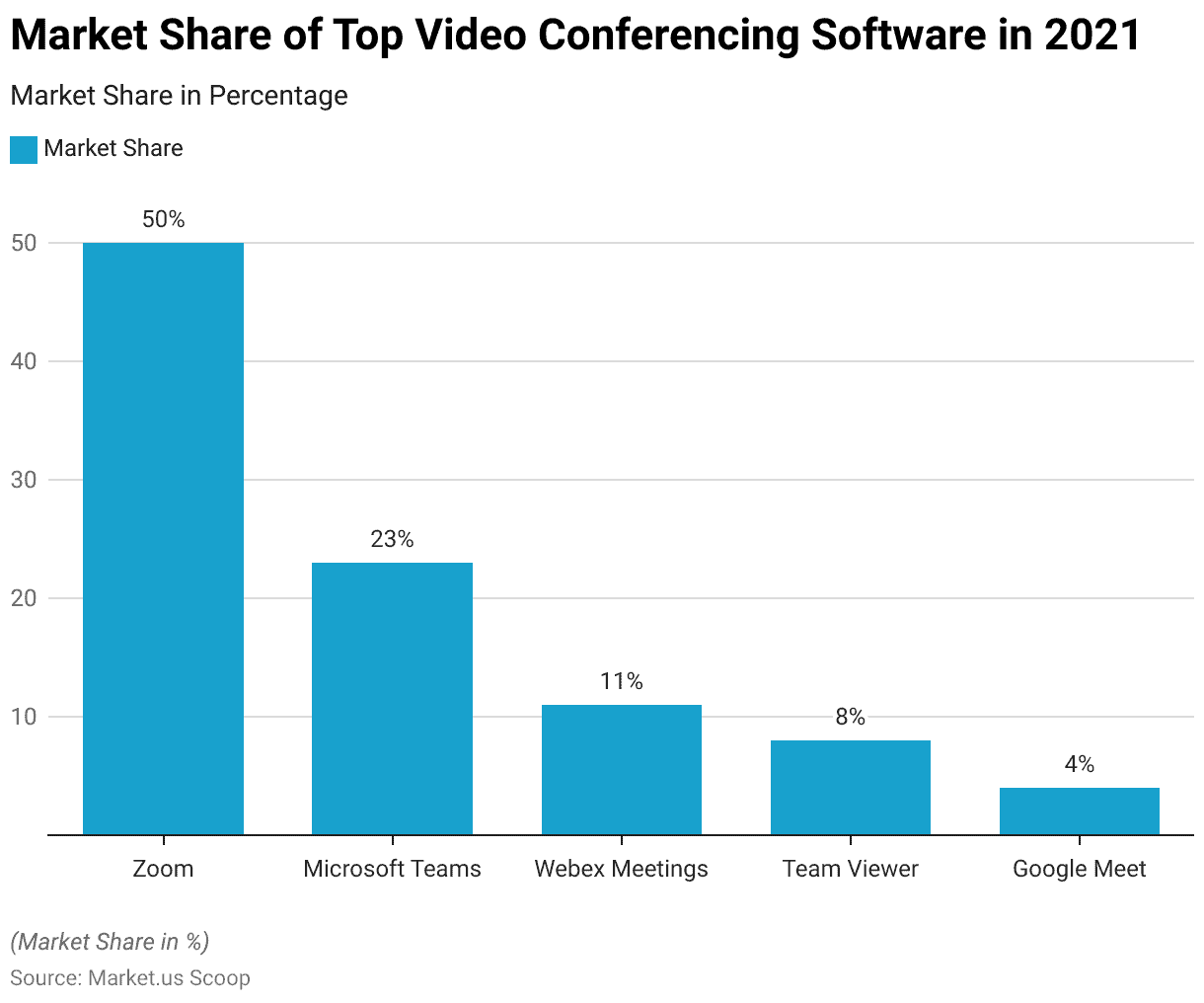
Adoption of Collaboration Software Solutions Statistics
- In 2021, a significant 79% of workers globally utilized digital collaboration tools.
- An overwhelming 99% of individuals working remotely reported using, on average, 4.8 different conferencing apps.
- There was a dramatic surge in the adoption of online collaboration platforms, witnessing a 322% increase from May 2019 to May 2020.
- 90% of Microsoft Teams users prefer to use the platform solely on their desktop devices.
- Meanwhile, 70% of the usage for Zoom on mobile devices is attributed to users who exclusively use the app on mobile.
- In the United States, individuals dedicated a total of 6 billion minutes to utilizing collaboration tools in May 2020.
- Furthermore, during the same period, 40% of those using Microsoft Teams also utilized Zoom.
- Additionally, to accommodate remote workforces, 72% of businesses introduced at least one new collaboration application in 2021.
(Source: High Fidelity-2021, IDC-2020, Comscore-2020, Unify Square-2020)
Benefits of Collaboration Software Solutions Statistics
- A majority of teleworkers, 65%, view video conferencing and instant messaging as effective alternatives to face-to-face interactions.
- Approximately 40% of employees believe their jobs can be primarily conducted from home.
- A significant 73% of the workforce favors the continuation of flexible remote work options due to the flexibility they provide.
- In line with this trend, 63% of organizations experiencing growth have adopted “productivity-anywhere” models facilitated by online collaboration tools.
- Additionally, 70% of technology entrepreneurs have observed that remote work has either maintained or enhanced productivity levels.
- In the United States, 35% of workers feel they can perform their jobs entirely remotely, while another 28% estimate they can achieve 90% efficiency when working from home.
(Source: Pew Research-2020, Microsoft-2021, Accenture-2021, Entrepreneur-2020, Microsoft-2021)
Challenges in the Adoption of Collaboration Software Solutions
- 58% of enterprises identify risk assessment as the primary security and compliance function necessary for managing communications effectively.
- Meanwhile, 64% of organizations regularly encounter challenges when attempting to integrate technologies and applications from various collaboration vendors.
- Based on productivity signals from Microsoft 365, 54% of remote workers report feeling overworked, and 39% describe feeling exhausted.
- Between July and September 2021, there was a surge of over 200% in the utilization of AI capabilities, indicating a demand for enhanced engagement in meetings.
- Additionally, 98% of employees express regular dissatisfaction with video meetings conducted from home.
(Unify Square-2020, Cisco, Microsoft)
Recent Developments
Merger and Acquisition Activity:
Major collaboration software companies have engaged in mergers and acquisitions to expand their product portfolios, enhance capabilities, and consolidate market share.
New Product Launches and Updates:
Collaboration software providers have introduced new products and updates to meet the evolving needs of remote and distributed teams.
Innovations include features such as real-time collaboration, video conferencing, task management, and integration with other productivity tools.
Funding and Investment:
Venture capital firms and investors have shown strong interest in collaboration software startups, providing significant funding and capital infusion.
Funding rounds for collaboration software companies have reached [insert specific numeric information] in recent quarters.
Partnerships and Integrations:
Collaboration software companies have formed partnerships with other technology providers and platforms to offer seamless integrations and interoperability.
Collaborative efforts aim to enhance user experience, increase productivity, and streamline workflows for businesses and organizations.
Focus on Security and Data Privacy:
Collaboration software vendors have prioritized security and data privacy features to protect sensitive information and ensure compliance with regulations.
Encryption, access controls, and compliance certifications are key aspects of collaboration software solutions to address security concerns.
User Experience and Accessibility Enhancements:
Collaboration software providers have invested in improving user experience and accessibility features to cater to diverse user demographics and preferences.
User-centric design, intuitive interfaces, and mobile optimization contribute to the usability and adoption of collaboration tools.
Conclusion
Collaboration Software Statistics – Collaboration software has emerged as a vital component of the modern workplace, enhancing communication and project coordination across distances.
Its growing adoption is fueled by the rise of remote and hybrid work models, underlining its significance in keeping teams connected and productive.
However, issues like integration challenges, security risks, and user burnout must be tackled to leverage its benefits fully.
With the ongoing integration of technologies such as AI and the demand for flexible working conditions, collaboration tools are set to become even more embedded in our work routines.
As businesses adapt to the digital age, effective collaboration, irrespective of location, will be key to success.
The anticipated growth in the collaboration software market underscores its role in fostering organizational agility and resilience amid constant change.
FAQs
Collaboration software comprises digital tools designed to help individuals and teams work together more efficiently. It enables real-time communication, project management, document sharing, and collaborative task completion, regardless of the participants’ locations.
Collaboration software enhances productivity by streamlining communication and project workflows. It reduces the need for physical meetings, facilitates remote work, improves project tracking, and ensures that all team members have access to the same information and resources.
Key features include real-time messaging and video conferencing, task and project management tools, document sharing and co-editing capabilities, calendar and scheduling options, and integration with other productivity tools.
Yes, it is particularly beneficial for remote and distributed teams, providing a virtual platform for communication, collaboration, and coordination of tasks, thereby bridging the gap between different geographical locations.
Challenges may include the potential for information overload, difficulties in integrating various tools, security and privacy concerns, and the need for proper training to ensure all team members can use the software effectively.
Discuss your needs with our analyst
Please share your requirements with more details so our analyst can check if they can solve your problem(s)



